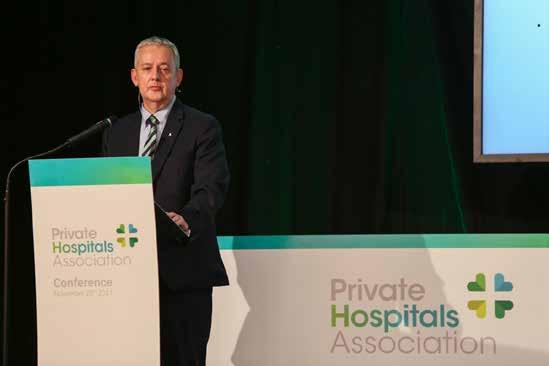
15 minute read
Partnership is key to growth hears Private Hospitals Association Annual Conference
Private Hospitals Association Committed to New Era of Partnership
A sizable majority of Irish people believe healthcare in Ireland should be planned and delivered by the public and private healthcare sectors both working in partnership to help address the country’s key acute hospital problems. The finding contained in research published by the Private Hospitals Association also highlights a fall in public support and understanding of Sláintecare, with 46% of those surveyed considering that the key aims of Sláintecare are achievable.
The research results were presented at a special conference hosted by the Private Hospitals Association in Dublin, and revealed that amongst 1000 people recently surveyed, 65% admitted to having a poor understanding of Sláintecare and its goals. While 62% of those surveyed believe that private care should be removed from the public hospital system, almost 7 out of 10 surveyed (69%) believe healthcare in Ireland should be planned and delivered by both the private and public sectors working in partnership rather than on a separate basis. An even more sizable 83% of people say both sectors should work jointly to clear the large backlog that exists in hospital waiting lists. Private Hospitals Association member hospitals operate almost one-third of the acute hospitals in Ireland. PHA members treat over 400,000 patients annually in 18 hospitals located throughout Ireland. The half-day conference event which was addressed by Minister for Health, Stephen Donnelly, focussed on the changing relationship between private hospitals and the wider health sector in Ireland; the key lessons being learned from the COVID-19 pandemic; and the potential for new partnership models aimed at addressing the pressing health needs of our population. In his keynote address to the Conference, incoming Chairman Bill Maher, highlighted the potential for a new era of engagement, collaboration and partnership between the private and public healthcare systems in Ireland following on from the experiences gathered over the extraordinary 20 month period since the Covid-19 pandemic took hold here. He said, “While there can be few silver linings arising from a global pandemic, one significant positive we can point to is the greater level of understanding that now exists Bill Maher speaking at the Private Hospitals Association annual conference

between our sectors arising from our shared experiences since March 2018. This, in my view, paves the way for new pathways of working and collaborating together that will achieve improved outcomes for all patients.” A special focus of the conference was on current and future trends in private health care – how patient care will evolve over the next five to ten years and the priorities for investment to ensure provision of the most up-to-date and appropriate treatments. The Conference also looked at the partnership role with health insurers going forward and the global trend of focusing on keeping people in good health, as well as making them better. The event came at an important juncture as the fallout continues from the impact of the Covid-19 pandemic on Irish healthcare delivery; as outpatient waiting lists in Ireland approach record highs and significant questions are being asked about the national strategy on the future of health care, Sláintecare. The Private Hospitals Association Conference which took place online and came live from the Herbert Park Hotel, featuring a range of speakers including the Minister for Health, private healthcare providers, insurers, health economists, pharma and med-tech leaders and the HSE.
Key Research Findings
• 62% of people believe private care should be removed from the public hospital system. • 69% believed healthcare in
Ireland should be planned and delivered by both sectors working together in partnership rather than on a standalone basis – 31% say it should be standalone.
• The public is divided on whether Sláintecare is achievable - 46% deemed it achievable, 54% said not. • 62% say it will take at least 15-20 years to implement
Sláintecare if at all.
• 69% also believe that both sectors should also work in partnership to deliver the extra 2,600 new hospital beds promised under Sláintecare over the next 15 years. • 83% say hospital waiting lists should be tackled in partnership with the private system rather than the public system seeking to resolve the problem alone. • 58% of those surveyed had private health insurance. • Of the 50% of those who had recently sought to access private healthcare, 67% of those described their experience as either very good or good, 21% as okay and 12% as poor.
67% rate their experience of accessing private hospital treatment good or very good, down 5%. 12% rate the experience as poor or very poor.
Experience of Accessing Private Hospital Treatment
Very Good
31% Good
36%
67% Okay
21% Poor
7% Very Poor
5%
12%
What are the main factors affecting physician implementation of hospital pharmacist recommendations to optimise medication appropriateness?


Written by Mr Robert Callaghan (top) and Dr Kieran Dalton, Pharmaceutical Care Research Group, School of Pharmacy, University College Cork, Cork, Ireland
Hospital pharmacists play a key role in identifying and resolving instances of potentially inappropriate prescribing, particularly in multimorbid older patients with polypharmacy. This has been backed up by evidence from many randomised controlled trials showing that pharmacists reduce the incidence of adverse drug reactions, emergency department visits, and medicationrelated readmissions. Importantly, pharmacist interventions with a high proportion of medication recommendations implemented by physicians are more likely to achieve significant improvements in patient outcomes compared to those with lower implementation rates, which generally result in non-significant patient outcomes. However, despite the importance attributed to implementation rates, very little research had been conducted to explore in depth the main factors affecting physicians’ implementation of hospital pharmacist recommendations. Therefore, researchers from University College Cork decided to investigate this by conducting oneon-one semi-structured interviews with hospital pharmacists and physicians from two Irish teaching hospitals. In total, 14 interviews were performed, including six pharmacists (sampled based on experience) and two physicians from each of the following grades: intern, senior house officer, registrar, and consultant. At the time of the interviews, pharmacists did not have prescribing authority within either hospital, and primarily worked according to a wardbased clinical pharmacy model. Outlined below are the five major themes that were generated from the interviews, which describe the main factors affecting physicians’ implementation of hospital pharmacist recommendations.
1. Clinical relevance and complexity of the recommendation
Clinical relevance and priority:
Put simply, recommendations that are of high clinical relevance and clearly provide patient benefit or prevent patient harm will be implemented. Physicians are more likely to prioritise the implementation of recommendations on patients’ acute issues, as that is their focus in hospital. The urgency with which the recommendation must be addressed affects its prioritisation relative to physicians’ other work commitments.
“…it's probably something that might not be deemed particularly important or it's not going to cause any adverse effect, at least in the short term. You know, those kinds of things would be slower to be acted upon, maybe because people would have graded it in their head as to how important that particular intervention is based on other jobs that they have to do that day” [Pharmacist 3] Recommendations related to issues that are less clear-cut – the “grey areas”, as one pharmacist described – are less likely to be implemented as they may not be as straightforward or not supported by evidence-based guidelines. These recommendations therefore require greater knowledge and decision-making, and less likely to be implemented by junior doctors practising in the hospital.
2. Interprofessional communication
Route of communication:
Recommendations provided verbally, especially when communicated face to face, are significantly more likely to be implemented than those in written format. This is likely because a synchronous verbal discussion allows the pharmacist to best explain their rationale, and thereafter the physician can clarify their choice for implementation or not.
Pharmacist manner and language: Pharmacist recommendations delivered in a clear, confident, and assertive way are much more likely to be implemented. However, it was pointed out that there is a fine balance between assertiveness and arrogance; with pharmacists often playing a ‘corrective role’, it is important that this is not misconstrued. Therefore, one way that pharmacists can facilitate implementation is by adjusting their language to minimise causing offence. “…we do not want to be arrogant either by coming in and saying ‘you are wrong’. My recommendations are always ‘consider doing this’, because the recommendations I have made are based on this guideline” [Pharmacist 2]
3. Prescriber role and identity Physician grade and experience:
The physician’s level of experience was emphasised as important. Most interviewees acknowledged that junior doctors would be more likely to implement pharmacists’ recommendations. However, it was noted that this may in some cases be a blind trust, either due to a lack of knowledge or due to hierarchical influences.
“I remember back when I was an intern and I would have trusted everybody more senior than me, which would have been everyone. So, I might have just done it without thinking about it too much…” [Physician 6] In other scenarios, particularly for more complex decisions, junior doctors may be less likely to implement pharmacist recommendations, as they may not have the authority to act upon them – deferring responsibility to their seniors.
“I feel like I do not have the power to make the pharmacy decisions really. So, really, I would have to talk to the registrar or the consultant on the service…” [Physician 7] It was highlighted that senior doctors may be more resistant to pharmacists’ recommendations, and that their views can have an important “trickle-down effect” that influences their junior colleagues to either be welcoming or dismissive of pharmacist recommendations. Specialty: Typically, when a pharmacist recommendation concerns a medication in a physician’s specialty, it is likely that a physician will readily accept any appropriate recommendations. However, an interesting contrast appeared regarding recommendations that are less explicitly aligned to the specialty of physicians. Some implement more recommendations as they welcome pharmacists’ advice in areas beyond the physicians’ expertise. Conversely, other specialists may be slower to implement pharmacist recommendations beyond their perceived scope of practice, especially when it may encroach on other specialists’ areas of expertise. Personality: Interviewees explained that the physician’s personality can be another factor affecting implementation, with some physicians being open-minded and willing to take recommendations on board, whilst others are less receptive to pharmacists’ advice – which may be viewed as a challenge to physicians’ judgement or encroachment on their role. “We have very supportive physicians, they are very supportive of pharmacy and are very happy to take your recommendations on board and would always thank us for flagging things. And then we would have physicians who do not like to be questioned on their treatment decisions.” [Pharmacist 2]
4. Knowing each other and developing trusting relationships
Knowing each other: Although not essential, interviewees indicated that a physician knowing the pharmacist facilitates implementation. Familiarity enhances pharmacistphysician interactions, supports the development of collaborative relationships, and contributes to regular uptake of recommendations. However, it was evident from the interviews that pharmacists placed a greater importance on knowing each other than the physicians. “…it's definitely important that… they know you I suppose, that they have seen you around, they know who you are… they have had positive interactions with you before definitely I think improves the likelihood that they'll take on board what you have to say.” [Pharmacist 5] Relationship-building: Sharing a greater rapport and interpersonal connection increases the likelihood of implementation. However, frequent staff changeovers hinder pharmacists’ formation of these relationships, particularly with junior doctors, and therefore “starting from scratch again” with the need to recurrently develop new pharmacist-physician relationships.
Trusting pharmacists’
recommendations: It was found that physicians may not be aware of pharmacists’ training, skills, or roles in medication optimisation, which can influence their trust in pharmacists’ recommendation. Building trust usually takes time; one way this can be achieved is by pharmacists consistently providing high-quality recommendations to the physician. “I think once you prove yourself to them a bit, they warm to you a bit. I suppose it would be the same as any new doctor. They'd be slow to trust you until there's trust there.” [Pharmacist 1]. When trust has been established, this may be manifested as physicians seeking out and approaching pharmacists for advice, and subsequently implementing their recommendations.
5. The hospital environment
Timing and opportunity: Despite the preference for face-to-face discussions, it is not always possible for pharmacists to have a clear opportunity to meet with physicians in the busy hospital environment, thus often relying on impromptu opportunistic encounters on wards and corridors. It was indicated that implementation would be facilitated by pharmacists having a prescheduled time to discuss their recommendations, such as a ward round or multidisciplinary team meeting. “…unless you are on a round with them, it's difficult to find [an opportunity to meet] afterwards. You're running around bleeping people, nosing into doctors' rooms to see if someone is in there…so it can be…it can make it difficult” [Pharmacist 4]
Documentation in health
records: When there is insufficient information about the physicians' plan for the patient documented in health records, this can contribute to pharmacists making recommendations that are of lower relevance or not in line with the physicians' plan, therefore meaning recommendations are less likely to be implemented.
Staffing levels and
pharmacist presence: Insufficient levels of hospital pharmacists were found to be an issue. With a greater pharmacist presence, this would increase accessibility to physicians and face-to-face discussions, and allow more time for collaborative teamwork – all contributing to more recommendations being implemented. Working as a team: Interviewees on both sides indicated that the hospital pharmacist may often be perceived as an “outsider”, and affirmed that pharmacists who work closely with physicians as part of a team are more likely to have their recommendations implemented. “You know it's so much better to work with the physicians as a team rather than work with them in isolation on the ward. They do not get to know you. They do not build a relationship” [Pharmacist 6]
Implications of this research
This study supports previous research which showed that synchronous two-way discussion and face-to-face contact not only help with the implementation of pharmacist recommendations, but are also key components in developing collaborative pharmacist-physician working relationships. It additionally reiterates that pharmacists’ written recommendations are less likely to be implemented by physicians. Although, this may be confounded by the fact that less urgent recommendations or those of lower clinical relevance may be communicated more often in written form, and therefore may not be implemented as readily. However, even with face-to-face communication, this research demonstrates that implementation may be hampered if the recommendation recipient is not a decision-maker on the medical team. It would therefore be prudent, where possible, to have more scheduled discussions between pharmacists and senior physicians, rather than solely relying on spontaneous interactions. Pharmacist involvement with ward rounds has been shown to significantly reduce preventable adverse drug events as it provides pharmacists the opportunity to proactively prevent inappropriate prescribing, rather than the more traditional reactive role of retrospectively reviewing patients’ prescriptions. With recurrent hospital staff changeover, it is important that pharmacists develop strong relationships with senior physicians; this modelling of trust with pharmacists should have the “trickle-down effect” described to encourage junior physicians to trust pharmacists and implement their recommendations. However, what was clear from the interviews, and which may hinder the formation of such relationships, was the hierarchical culture in hospitals. It was described how pharmacists often utilise indirect communication methods to facilitate implementation (e.g. gentle reminders, suggestions, questions) to minimise embarrassment or defensive behaviour from physicians. This type of culture impedes teamwork in healthcare; whilst greater interprofessional education has been suggested as a strategy to increase collaboration between healthcare professionals, further evidence is required to explicitly show its impact on patient outcomes. With interviewees emphasising the importance of pharmacists and physicians working as part of a team, consideration should be given to the clinical pharmacy models used in hospitals. Previous research from Tallaght University Hospital has shown that a team-based pharmacist approach resulted in significantly more recommendations being implemented compared to standard ward-based care (95.9 versus 69.3%), with only the team-based approach resulting in a significant improvement in medication appropriateness. Moreover, the team-based recommendations were implemented earlier, which may be vital in the prevention of adverse drug reactions. However, with team-based models, pharmacists may not be able to review the same number of patients, therefore necessitating increased staffing levels.
Conclusion
This study has generated a greater understanding of the key factors affecting physician implementation of pharmacist recommendations. It is therefore important to consider these facilitators and barriers in order to enhance the implementation of pharmacists’ recommendations, and ultimately to optimise both medication appropriateness and patient safety going forward. The article above was Written by Mr Robert Callaghan (4th year pharmacy student) and Dr Kieran Dalton, and is based on a peer-reviewed research paper conducted by Dr Kieran Dalton, Dr Aoife Fleming, Professor Stephen Byrne (School of Pharmacy, University College Cork), and Professor Denis O’Mahony (Cork University Hospital). For more information on this study, please review the open access paper at: https://bpspubs. onlinelibrary.wiley.com/doi/ full/10.1111/bcp.14987
What is already known about this subject
• Some pharmacist interventions have a lower proportion of recommendations implemented by physicians, which are more likely to result in non-significant patient outcomes compared to pharmacist interventions with high implementation rates. • There is a paucity of qualitative research that has explored the underlying behavioural determinants of physician nonimplementation of pharmacist recommendations.
What this study adds
• This study reveals the key factors affecting physician implementation of hospital pharmacist recommendations: the clinical relevance and complexity of recommendations; the method of interprofessional communication; the physician role and identity; the nature of the pharmacist–physician relationship; and the hospital environment. These factors must be considered in designing future pharmacist interventions.







